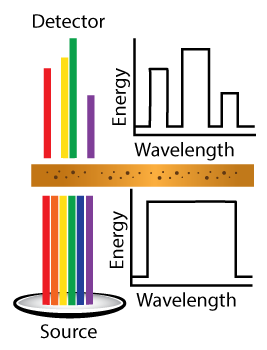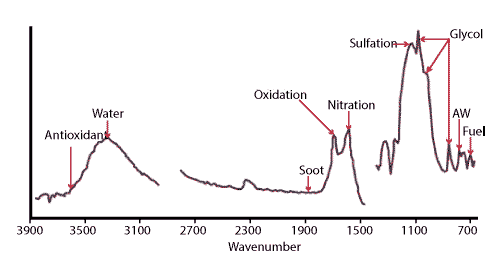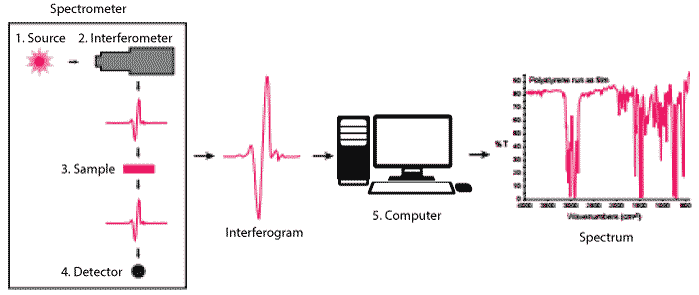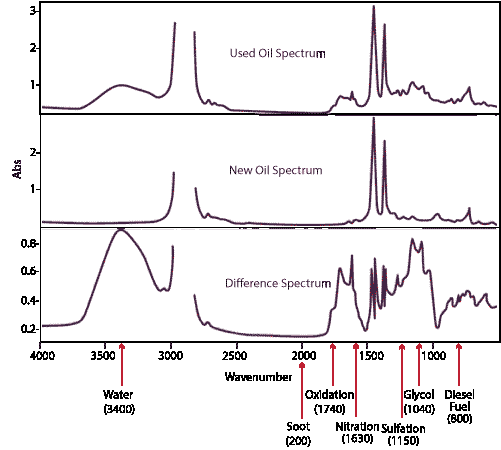Benefits of FTIR Oil Analysis
 Fourier transform infrared (FTIR) spectroscopy is a versatile tool used to detect common contaminants, lube degradation byproducts and additives within lubricating oils. It has become a widely used technique for quickly assessing multiple lubricant characteristics, and yet many people don’t fully understand how it works. When exposed to infrared radiation, molecules absorb radiation at very specific wavelengths. Knowing this, you can pass infrared radiation through a sample and use a detector on the other side of the sample to identify the molecules found in that sample.
Fourier transform infrared (FTIR) spectroscopy is a versatile tool used to detect common contaminants, lube degradation byproducts and additives within lubricating oils. It has become a widely used technique for quickly assessing multiple lubricant characteristics, and yet many people don’t fully understand how it works. When exposed to infrared radiation, molecules absorb radiation at very specific wavelengths. Knowing this, you can pass infrared radiation through a sample and use a detector on the other side of the sample to identify the molecules found in that sample.
Much like a fingerprint, no two molecules produce the same pattern or wavelength. This is very useful in being able to identify the material composition of a sample. Qualitative analysis becomes easy because of this fact. When a software algorithm is used to plot the resulting spectrum, a visual representation is generated.
This test method is relatively quick to perform and is capable of simultaneously detecting multiple parameters, including antioxidants, water, soot, fuel, glycol, oil oxidation and certain additives. Adding to the power of this qualitative measurement, the size of the peaks is a direct indication of the amount of the specific material found in the sample.
 For a better understanding, let’s take a more in-depth look at the process and anatomy of analyzing a sample. The first component in the system is the source. The source will emit infrared energy and send it through an aperture to control the amount being presented to the sample.
For a better understanding, let’s take a more in-depth look at the process and anatomy of analyzing a sample. The first component in the system is the source. The source will emit infrared energy and send it through an aperture to control the amount being presented to the sample.
Next, the beam enters the interferometer where it is “encoded” using a series of stationary and movable mirrors. This encoding is a way to produce a signal that consists of all the important infrared frequencies simultaneously.
The beam then enters the sample, and certain frequencies of the energy are absorbed. The energy that escapes the sample is sent to the detector where it is measured. This measured signal is then sent to a computer where Fourier transformation takes place. Fourier transformation is a mathematical process where a waveform can be broken into an alternate representation for easy viewing. At this point, the results are plotted on the screen, and a simple analysis can be made by the technician.
Since most used oil samples are complex mixtures of thousands of different molecules, including base oil molecules, additives, oil degradation byproducts, wear debris and contaminants, the infrared spectrum of the sample is typically complex and can be difficult to interpret with any degree of certainty, as some wavenumbers may overlap. Despite these drawbacks, FTIR still has great value in used oil analysis and is employed by the majority of oil analysis labs as a screening tool.
| Component | Spectral Location | Measurement | Traditional Measurement | Sensitivity |
|---|---|---|---|---|
| Soot | 2000 | Carbon Load | Total Insolubles | Insensitive |
| Oxidation | 1750 | Oil Degradation | BN, AN, Viscosity | Partially |
| Nitration | 1630 | Oil Degradation | BN, AN, Viscosity | Partially |
| Sulfation | 1150 | Oil Degradation | BN, AN, Viscosity | Partially |
| Water | 3400 | Contaminant | Karl Fischer | Partially |
| Glycol | 880 | Contaminant | Gas Chromatography (GC) | Very |
| Diesel | 800 | Contaminant | Flash Point Viscosity, GC | Extremely |
| Gasoline | 750 | Contaminant | Flash Point Viscosity, GC | Extremely |
| ZDDP (AW) | 980 | Additive | Elemental Spectroscopy | Extremely |
To minimize the effects of the base oil and additive molecular resonances, FTIR analysis of used oil samples is a three-stage process. The first stage is to record the FTIR spectrum of a new oil sample to obtain a baseline FTIR trace. The second stage is to record the same FTIR spectrum of the used oil sample. The third and final stage is to subtract the new oil baseline, often referred to as the new oil reference, from the used oil spectrum to obtain the difference spectrum. In theory, the difference spectrum allows the changes in both the chemical composition of the oil, such as oil oxidation (represented by an increase in a peak centered around 1740 cm-1), and any contaminants to be measured without interference from the new oil molecular resonances.

The one major limitation of this difference spectrum procedure is that it is often not practical to send a sample of new oil with the used oil sample each time analysis is required. In order for the procedure to be accurate, the new oil reference for this purpose should not only be the same type, brand and grade as the used oil, but also from the same manufactured batch of oil.
Another area where FTIR can prove extremely valuable is in determining significant changes in oil chemistry, such as what might be expected when two oils with different chemical compositions are added together because of cross-contamination. The figure below shows the FTIR spectrum of a blend of a polyalphaolefin-based synthetic oil and a phosphate ester electro-hydraulic control (EHC) fluid. By recording the FTIR spectrum of the suspected blend along with the known new oil reference spectra of the pure polyalphaolefin and pure EHC fluid, this accidental mixing can be confirmed. In fact, when an unknown contamination issue is suspected, it often is advisable to immediately run an FTIR spectrum in conjunction with a fresh new oil reference whenever possible.
FTIR is a valuable addition to any oil analysis program. By understanding how the technique works as well as its strengths and limitations, oil analysts and end users can obtain a vast amount of information when utilizing it alongside other standard test methods and strategies.
Fourier transform infrared (FTIR) spectroscopy is a versatile tool used to detect common contaminants, lube degradation byproducts and additives within lubricating oils. It has become a widely used technique for quickly assessing multiple lubricant characteristics, and yet many people don’t fully understand how it works. When exposed to infrared radiation, molecules absorb radiation at very specific wavelengths. Knowing this, you can pass infrared radiation through a sample and use a detector on the other side of the sample to identify the molecules found in that sample.
 Much like a fingerprint, no two molecules produce the same pattern or wavelength. This is very useful in being able to identify the material composition of a sample. Qualitative analysis becomes easy because of this fact. When a software algorithm is used to plot the resulting spectrum, a visual representation is generated
Much like a fingerprint, no two molecules produce the same pattern or wavelength. This is very useful in being able to identify the material composition of a sample. Qualitative analysis becomes easy because of this fact. When a software algorithm is used to plot the resulting spectrum, a visual representation is generated
This test method is relatively quick to perform and is capable of simultaneously detecting multiple parameters, including antioxidants, water, soot, fuel, glycol, oil oxidation and certain additives. Adding to the power of this qualitative measurement, the size of the peaks is a direct indication of the amount of the specific material found in the sample.
For a better understanding, let’s take a more in-depth look at the process and anatomy of analyzing a sample. The first component in the system is the source. The source will emit infrared energy and send it through an aperture to control the amount being presented to the sample.
Next, the beam enters the interferometer where it is “encoded” using a series of stationary and movable mirrors. This encoding is a way to produce a signal that consists of all the important infrared frequencies simultaneously
The beam then enters the sample, and certain frequencies of the energy are absorbed. The energy that escapes the sample is sent to the detector where it is measured. This measured signal is then sent to a computer where Fourier transformation takes place. Fourier transformation is a mathematical process where a waveform can be broken into an alternate representation for easy viewing. At this point, the results are plotted on the screen, and a simple analysis can be made by the technician.
 Since most used oil samples are complex mixtures of thousands of different molecules, including base oil molecules, additives, oil degradation byproducts, wear debris and contaminants, the infrared spectrum of the sample is typically complex and can be difficult to interpret with any degree of certainty, as some wavenumbers may overlap. Despite these drawbacks, FTIR still has great value in used oil analysis and is employed by the majority of oil analysis labs as a screening tool.
Since most used oil samples are complex mixtures of thousands of different molecules, including base oil molecules, additives, oil degradation byproducts, wear debris and contaminants, the infrared spectrum of the sample is typically complex and can be difficult to interpret with any degree of certainty, as some wavenumbers may overlap. Despite these drawbacks, FTIR still has great value in used oil analysis and is employed by the majority of oil analysis labs as a screening tool.
To minimize the effects of the base oil and additive molecular resonances, FTIR analysis of used oil samples is a three-stage process. The first stage is to record the FTIR spectrum of a new oil sample to obtain a baseline FTIR trace. The second stage is to record the same FTIR spectrum of the used oil sample. The third and final stage is to subtract the new oil baseline, often referred to as the new oil reference, from the used oil spectrum to obtain the difference spectrum. In theory, the difference spectrum allows the changes in both the chemical composition of the oil, such as oil oxidation (represented by an increase in a peak centered around 1740 cm-1), and any contaminants to be measured without interference from the new oil molecular resonances
The one major limitation of this difference spectrum procedure is that it is often not practical to send a sample of new oil with the used oil sample each time analysis is required. In order for the procedure to be accurate, the new oil reference for this purpose should not only be the same type, brand and grade as the used oil, but also from the same manufactured batch of oil.
Another area where FTIR can prove extremely valuable is in determining significant changes in oil chemistry, such as what might be expected when two oils with different chemical compositions are added together because of cross-contamination. The figure below shows the FTIR spectrum of a blend of a polyalphaolefin-based synthetic oil and a phosphate ester electro-hydraulic control (EHC) fluid. By recording the FTIR spectrum of the suspected blend along with the known new oil reference spectra of the pure polyalphaolefin and pure EHC fluid, this accidental mixing can be confirmed. In fact, when an unknown contamination issue is suspected, it often is advisable to immediately run an FTIR spectrum in conjunction with a fresh new oil reference whenever possible
FTIR is a valuable addition to any oil analysis program. By understanding how the technique works as well as its strengths and limitations, oil analysts and end users can obtain a vast amount of information when utilizing it alongside other standard test methods and strategies
About the Author
Jeremy Wright is the Vice President of Technical Services for Noria Corporation. He serves as a senior technical consultant for Lubrication Program Development projects and as a senior instructor for Noria’s Machinery Lubrication I and II training courses. He is a certified maintenance reliability professional through the Society for Maintenance and Reliability Professionals, andholds Machine Lubricant Analyst Level III and Machine Lubrication Technician Level II certifications through the International Council for Machinery Lubrication. Contact Jeremy at jwright@noria.com.
